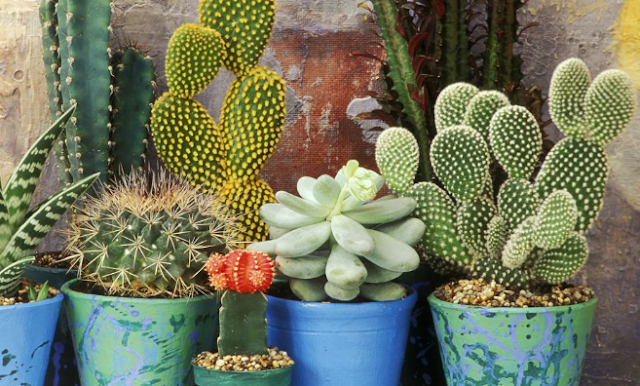 |
Cultivation procedure of cactus
1. Climate
Cacti can tolerate wide range of temperature. Except the pure tropical species, all cacti are able to tolerate lower temperature. Very high or low temperature adversely affect the growth of many species of cacti. At a temperature above 35°C under the blazing sun, plants may show sign of scorching or turn yellow. In such condition the plant should be shaded off. Most epiphytic species requires half- shade and a moist atmosphere.
2. Soil:
The soil for cacti, in general should be porous and permeable. Almost all species thrive well in a porous calcareous soil and there is a number of species for which a calcareous soil is necessary. Lime mortar from old building, hard limestones, marble or even crushed valves of oyster or other shell fish, roughly powdered and passed through a sieve to remove the fine dust, provide an excellent materials to add to the soil. Some leaf mould, thoroughly rotted should form a part of the compost. Very ell rotted cow manure is also an useful ingredient in the compost for the cacti.
Undecomposed organic matter is sure to give trouble and causes rotting of the roots. Chemical fertilizer force growth and due to excessive succulence the plant becomes susceptible to drought and infection. Small of bone meal, super – phosphate or basic slag may be added to the compost. The compost should be watered and allowed to remain for few months before using it. A small quantity of charcoal powder also help to keep the soil porous and sweet and prevent infection of roots.
Garden loam 2 parts, sand, old mortar or limestone gravel and leaf mould 1 part of each and some crushed charcoal are suitable for almost all species of cacti.
3. Planting and potting:
Many hardy cacti are grown in ground particularly in the rockeries. The land should be sloping and the soil should be porous and calcareous.
The best time for planting and potting is just at commencement of the growing season in spring. The soil should not be too wet and it always safe to place some dry soil beneath and around the roots.
Well – backed earthen plots are suitable for cacti, glazed or painted plots hampen the aeration of the roots.
The plots should be filled for about one – third with crocks or other drainage material, the large curved pieces to be placed on the holes and bottom and the hole topped over a thin by a thin layer of thick gravel, shingle or crocks, broken into small pieces.
If it is found the roots have become pot bound it is advisable to break off the pot with a sharp blow, instead of risking damage to the plant in trying to take it out and save the plot. The plant to ne repotted should be kept dry so that it easily comes out without injuring the roots and crocks are removed carefully.
The plants should be replanted just as deep down as in the previous pot. However, experience has shown that small plants, seedlings and also the cuttings are best planted close to the sides of the plot, spread out quickly, grow better and are less liable to rotting from occational, excess of moisture.
This practice of planting cacti along the sides of the plot is now generally adopted by the nurserymen. Unless the soil is in a perfectly dry condition, newly potted plants should not be watered for two or three days, but just lightly sprayed once or twice a day and placed in shade for about one week, afterwards in half – shade for at least an equal period before removing them to full sun.
4. Watering:
Watering is very important practice for cultivation of cacti. Under natural condition these plants are adapted to severe drought. Their external structures and also the physiological condition clearly indicate very little requirement of water.
In the summer, when the cacti grow, watering is done frequently. If these plants are kept in open in small pots daily watering may be necessary. Every time the soil is to be drenched completely so that excess water comes out through the drainage hole. At the resting period, during the winter months root remain inactive and watering should be minimized gradually from the autumn.
While watering, one should be careful that water does not accumulate in the depression of the plant. In Echinopsis, Echinocactus, Rebutia , the growing point on the top may rot. Fine spraying or syringing of water may be done in the morning.
5. Propagation:
The propagation of cacti is done through seeds, cuttings, offsets and grafting.